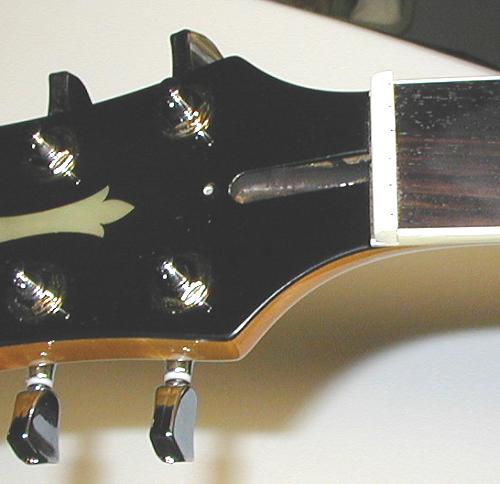This visual tutorial shows replacing a DeArmond Starfire's stock PVC nut for a new cow bone nut.

Old nut removed (most nuts are lightly glued and will tap or pull out easily).

New rough nut blank placed (NOT glued) in place. If you look REAL close, you'll see the pencil marks for the string spacing - I used a special Stew-Mac graduated nut slot spacing template.

Here, I use a "half pencil" to scribe the fret height on the new nut blank - it's just a reference line and I don't wanna cut below that or I'll "blow the nut". After you get some serious nut cuttin' chops, you won't need this line - but for now, use it because ... A) if the fretboard nut slot is curved, drawing the radius on the nut blank allows you to sand in the proper board radius onto the nut bottom so that it will seat properly inside the nut slot, and contact all of the wood with no gaps or flat spots, B) whether the fretboard nut slot bottom is curved or flat, once the nut blank is seated in the fretboard nut slot, use the half pencil to scribe a line on the nut blank - this line indicates two things: 1) you'll grind down the excess nut blank top to within about 3/32" of that line, and 2) you never wanna cut a string slot below that line!

See, it really is half of a pencil - I just ground a #2 pencil on a table sander wheel.

String up.

Cut the slots. FIRST, carefully start each slot with a few strokes of the high "E" string nutfile, then go over slots 2 thru 6 with the "B" string file, the go over slots 3 thru 6 with the "G" string file, etc. When all six are started, pop in the strings and wind'em up in tension (to pitch, if you like). Now, work on a slot at a time - I start with low "E" and work down the line. Remove enuf tension from the string to easily lift it off the slot, and commence to cutting. Make *sure* to bring the string back to concert pitch when checking the slot depth.
Using REAL nut files is the way to go as they have rounded edges to created round bottomed string slots. I use at least a few thousands of an inch larger slot file for a specific string gauge ... i.e. - .049" file for a .046" string, .020" nut file for a .016" string. You can create a larger slot by rolling the file from side to side as you file back and forth, if need be. A typical string gauge for Tele's and Strats is .046, .036, .026, .017, .013, .010 and I'll use the following respective files - .049", .040", .035", .020", .016", .013" - for a wider range of string gauges (9's thru 12's), try - .056", .045", .035", .028", .020", .016" (my favorite and most used file set).
You want to keep checking the nut relief at the 1st fret, during your slot cutting, First, wind up the string yer working on with some good tension, then just depress that string at the 2nd fret and measure the distance from the bottom of that string to the top of the 1st fret. Initially, shoot for a gap that's about 4 or 5 typing papers thick (or thicker!)- you can fine tune the slots later on (I like 'em real close, within a few thousands). KEEP CHECKING THE NUT RELIEF AS YOU CUT - it's good to do this after every 6 strokes or so! For gap checking, you can use an auto feeler gauge or some sheets of paper ... I do it by eyeball, but I've cut LOTS of nuts.
Keep the file parallel to the fretboard, and angled slightly down, as you file each slot. IF yer a newbie to nut cuttin', TAKE YOUR TIME. If the file starts to bind, clean the toothed edge on a piece of cloth and/or blow on it. Be careful, on the downward angle of the file, not to jab the end into the peghead! This whole process sounds tougher than it is to actually do.

Ready to rock 'n' roll (or whatever sounds you like to make!)